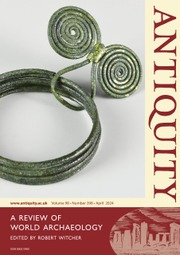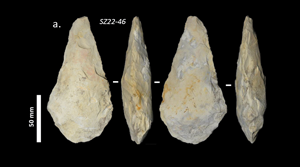Introduction
In Africa, the later Middle Pleistocene (c. 400 000–125 000 years ago) is poorly understood compared to the Upper Pleistocene (c. 125 000–12 000 years ago) (Ben Arous et al. Reference Ben Arous, Boisard and Leplongeon2025). This period is marked by the disappearance of the Acheulean, a chrono-cultural phase generally attributed to Homo erectus, and the appearance of the Middle Stone Age, a material culture closely linked to the emergence of Homo sapiens (Hublin et al. Reference Hublin2017). North Africa is recognised as a key area in the evolution of our species, as evidenced by the earliest current evidence for Homo sapiens at Jebel Irhoud (Morocco, c. 300 000 years ago) (Hublin et al. Reference Hublin2017). However, understanding the evolutionary processes that led to the development and expansion of Homo sapiens in Africa and the relationship between these process and environmental fluctuations is difficult because palaeoanthropological, archaeological and geochronological data from c. 400 000–125 000 years ago are scarce (Cancellieri et al. Reference Cancellieri2022; Ben Arous et al. Reference Ben Arous, Boisard and Leplongeon2025). To fill this major gap in human evolutionary models, the Sidi Zin Archaeological Project aims to reinvestigate the open-air site at Sidi Zin, an archaeological locality of great potential for the study of the Acheulean–Middle Stone Age transition in North Africa.
Re-assessing the potential of the Sidi Zin locality
Known since the 1930s (Gobert Reference Gobert1950), the site of Sidi Zin is about 10km south-west from the town of El Kef in northern Tunisia (Figure 1). First excavations were carried out between 1946 and 1948, in the 1980s and again in 2002 (see Boussoffara Reference Boussoffara1985; Belhouchet Reference Belhouchet2002; Marnaoui Reference Marnaoui2017). The sequence of limestone tuff (tufa) has revealed late Acheulean lithics (mostly limestone handaxes and cleavers) and Mousterian (or early Middle Stone Age) artefacts (e.g. small scrapers on local flint and quartzite). However, there has been no systematic spatial recording of the findings, and the original sedimentary sequence is no longer preserved.

Figure 1. Location of the Sidi Zin site (figure by authors).
A Tunisian-French team undertook a pilot fieldwork campaign in July 2022 under the codirection of Eslem Ben Arous and Nabiha Aouadi, opening up a new sector of the site to assess the archaeological potential for further research. This work falls within the scope of a broader long-term multidisciplinary research project focused on the El Kef region and aiming to: 1) establish a robust chronology for the site through multiple dating techniques; and 2) carry out high-resolution geomorphological, palaeoecological and cultural studies to understand hominin-environment interactions throughout the period of occupation.
Materials recovered in 2022
Previous work at Sidi Zin focused on typological and technological characterisation of the Late Acheulean and Middle Stone Age artefacts (Boussoffara Reference Boussoffara1985; Belhouchet Reference Belhouchet2002; Aouadi-Abdeljaouad & Belhouchet Reference Aouadi-Abdeljaouad and Belhouchet2008; Marnaoui Reference Marnaoui2017) but dating or geomorphological studies are yet to be undertaken. As the primary sequence was fully excavated by Gobert and is no longer preserved, it is therefore now not possible to link the previously excavated artefacts and faunal remains with new chronological studies. As a result, we opened in 2022 a new 1.8m-deep trench of 2.0 × 2.5m. The sediment is highly carbonated with presence of some fine grey sandy lenses but without any apparent stratification (Figure 2) whereas Gobert's first excavations revealed four units. Consequently, our fieldwork observations cannot, at present, be linked to the previous stratigraphy established by Gobert (Reference Gobert1950).

Figure 2. Preliminary stratigraphy of SZ2022 (figure by authors).
More than 300 objects were recovered during the 2022 excavation, including more than 30 handaxes, five cores, three cleavers and more than 60 retouched flint flakes. Fragmented Bovini and Equid fossils (Figure 3) were also identified, though these had been affected by various taphonomic processes (concretions, roots, water action). Technological studies of the lithic artefacts are ongoing but initial typological analysis indicates that elements traditionally attributed to the Late Acheulean are present as well as Middle Stone Age elements, which is in the first instance consistent with earlier observations (Gobert Reference Gobert1950) (Figure 2). Dating of this key archaeological site is currently underway using a combination of uranium-series and electron spin resonance (ESR) methods (Grün Reference Grün1989) applied to six fossil teeth collected from a test pit (Figure 3). Preliminary uranium-series ages obtained for the dental tissues of sample SZ22-32 provide minimum age estimates of c. 120 ka (Table 1).

Figure 3. Examples of material from SZ2022 found in situ (figure by authors).
Table 1. Uranium-series results for Bovini tooth SZ22-32. Errors are 2σ. U-series results were obtained with a Neptune multi-collector inductively coupled plasma mass spectrometer at Nanjing University.

Future directions
Preliminary results emphasise the potential of the Sidi Zin locality in the study of hominin occupations associated with the Late Acheulean and early Middle Stone Age in North Africa. Further excavation seasons with opening several trenches are planned around the Sidi Zin site (Figure 1) to explore fully human-environment interaction. In addition, the study of archaeological material (still in progress) will allow us to characterise the technologies and material culture of the hominin populations who lived in the region. Ongoing ESR dating of tooth enamel is expected to provide age constraints for the site occupation by combining them with uranium-series dating. Other ongoing analyses (zooarchaeological analyses of faunal remains, stable carbon and oxygen isotope analyses of faunal tooth enamel and lipid biomarkers analyses of sediments) are expected to contribute to knowledge of human subsistence economies and palaeoecology around the Acheulean–Middle Stone Age transition. Comparative analyses with other African sites will provide a pan-African perspective that is essential for understanding the processes that led to the emergence and diversification of our species.
Acknowledgements
We would like to thank the Tunisian Institut National du Patrimoine, the French Embassy, the Institut Français in Tunis and colleagues from the Histoire Naturelle de l'Homme Préhistorique for their administrative and financial support. We are also extremely indebted to Rached Jabali, an invaluable member of our team who financially supported part of the July 2022 field mission and whom we lost too early. We are grateful to three anonymous reviewers for providing feedback on this article.
Funding statement
The fieldwork has been additionally funded by the French-Tunisian Partenariats Hubert Curien (PHC) Utique project ‘Dynamiques paysagères quaternaires et actuelles dans la Dorsale tunisienne centrale (Hanchir El-Bez et ses environs’ (DYP-AQUA) headed by Vincent Lebreton and Noômène Fehri. Eslem Ben Arous’ postdoctoral research has received funding from the Fyssen Foundation and the European Union's Horizon 2020 research and innovation programme under the Marie Skłodowska-Curie grant agreement No. 101107408. Financial support for the ESR dating was provided by the Access to Research Infrastructures activity in the Horizon 2020 Programme of the EU (IPERION HS Grant Agreement n.871034), which we gratefully acknowledge.







